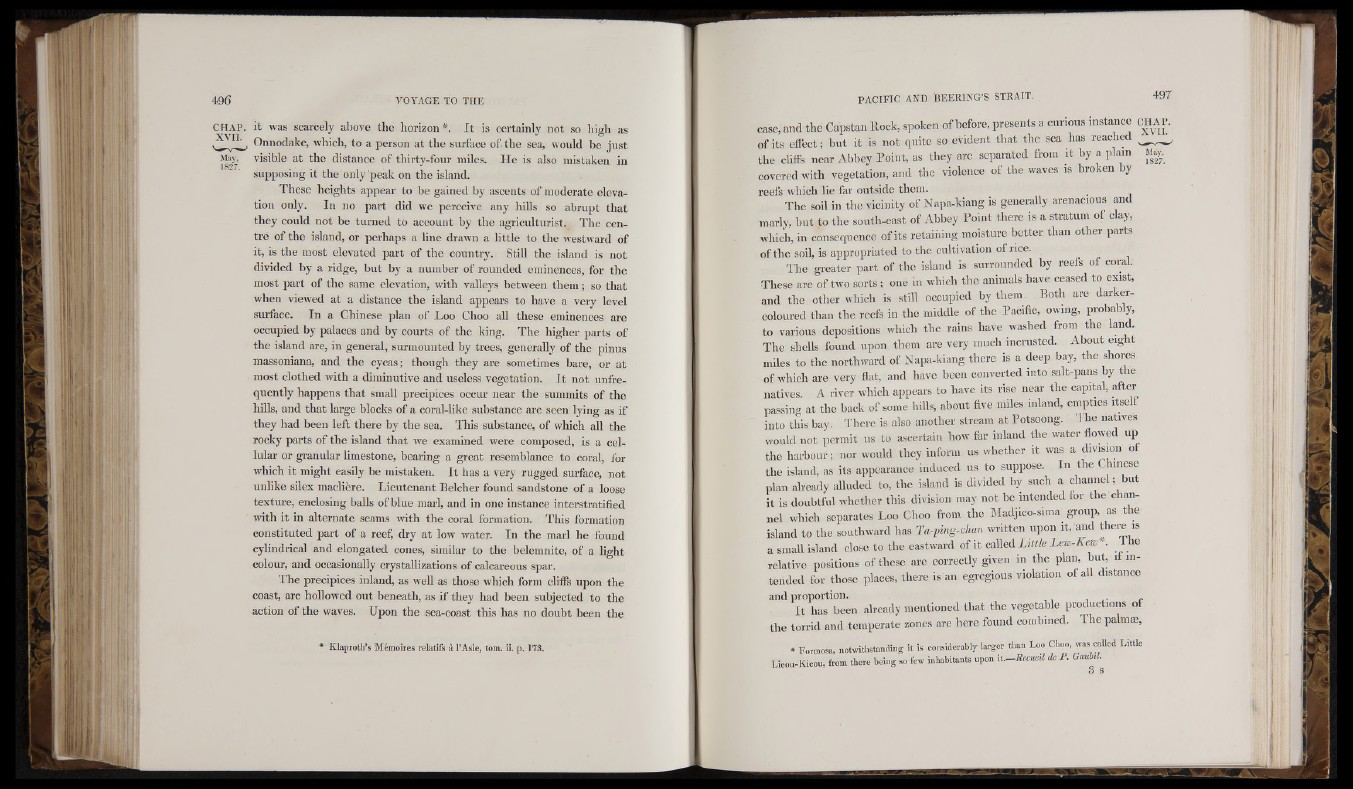
il
C H A P . it was scarcely above the horizon*. It is certainly not so high as
i i 7 Mav,
1827.
, Onnodake, which, to a person at the surfiice of. the sea, would be just
visible at the distance of thirty-four miles. He is also mistaken in
supposing it the only'peak on the island.
These heights appear to be gained by ascents of moderate elevation
only. In no part did vve perceive any hills so abrupt that
they could not be turned to account by the agriculturist. The centre
of the island, or perhaps a line drawn a little to the westward of
it, is the most elevated part of the country. Still the island is not
divided by a ridge, but by a number of rounded eminences, for the
most part of the same elevation, with valleys between them ; so that
when viewed at a distance tbe island appears to have a very level
surface. In a Chinese plan of Loo Choo all these eminences are
occupied by palaces and by courts of the king. The higher parts of
the island are, in general, surmounted by trees, generally of the pinus
massoniana, and the cycas; though they are sometimes bare, or at
most clothed with a diminutive and useless vegetation. It not unfrequently
happens that small precipices occur near the summits of the
hills, and that large blocks of a coral-like substance are seen lying as if
they had been left there by the sea. This substance, of which all the
rocky parts of the island that we examined were composed, is a cellular
or granular limestone, bearing a great resemblance to coral, for
which it might easily be mistaken. It has a very rugged surface, not
unlike silex maclière. Lieutenant Belcher found sandstone of a loose
texture, enclosing balls of blue marl, and in one instance interstratified
with it in alternate seams with the coral formation. This formation
constituted part of a reef, dry at low water. In the marl he found
cylindrical and elongated cones, similar to the belemnite, of a light
colour, and occasionally crystallizations of calcareous spar.
The precipices inland, as well as those which form cliffs upon the
coast, are hollowed out beneath, as if they had been subjected to the
action of the waves. Upon the sea-coast this has no doubt been the
• Klaproth’s Mémoires relatifs à l’A sia, tom. ii. p. 173.
case, and the Capstan Bock, spoken of before, presents a curious instance CHAP,
of its effect; but it is not quite so evident that the sea has reached
the cliffs near Abbey Point, as they are separated from it by a plain Mi^
covered with vegetation, and the violence of the waves is broken by
reefs which lie far outside them.
The soil in the vicinity of Napa-kiang is generally arenacious and
marly, but to the south-east of Abbey Point there is a stratum of clay,
which, in consequence of its retaiiiing moisture better than other parts
of the soil, is appropriated to tlie cultivation of rice.
The greater part of the island is surrounded by reefs of coral.
These are of two sorts; one in which the animals have ceased to exist,
and the other which is still occupied by them. Both are darker-
coloured than the reefs in the middle of the Pacific, owing, probably,
to various depositions which the rains have washed from the land.
The shells found upon them are very much incrusted. About eight
miles to the northward of Napa-kiang there is a deep bay, the shores
of which are very flat, and have been converted into salt-pans by the
natives A river which appears to have its rise near the capital, after
passing at the back of some bills, about five miles inland, empties itself
into this bay. There is also another stream at Potsoong. I he natives
would not permit ns to ascertain how far inland the water flowed up
the harbour; nor would they inform us whether it was a division ot
the island, as its appearance induced us to suppose. In the Chinese
plan already alluded to, the island is divided by such a channel; but
it is doubtful whether this division may not be intended for the channel
which separates Loo Choo from the Madjico-siraa group, as the
island to the southward has Ta-ping-chan written upon it, and there is
a small island close to the eastward of it called Little Lew-kew *. The
relative positions of these are correctly given in the plan, but, it intended
for those places, there is an egregious violation of all distance
and proportion.
It has been already mentioned that the vegetable productions of
the torrid and temperate zones are here found combined. The palma;,
. Formosa, notwitl,standing it is consifiorably larg e r than Loo Choo, was called L ittle
L ieou-Kieou, from th e re bein g so few inhabitants upon i t . - R e c u a l * 1 . Gaubd.